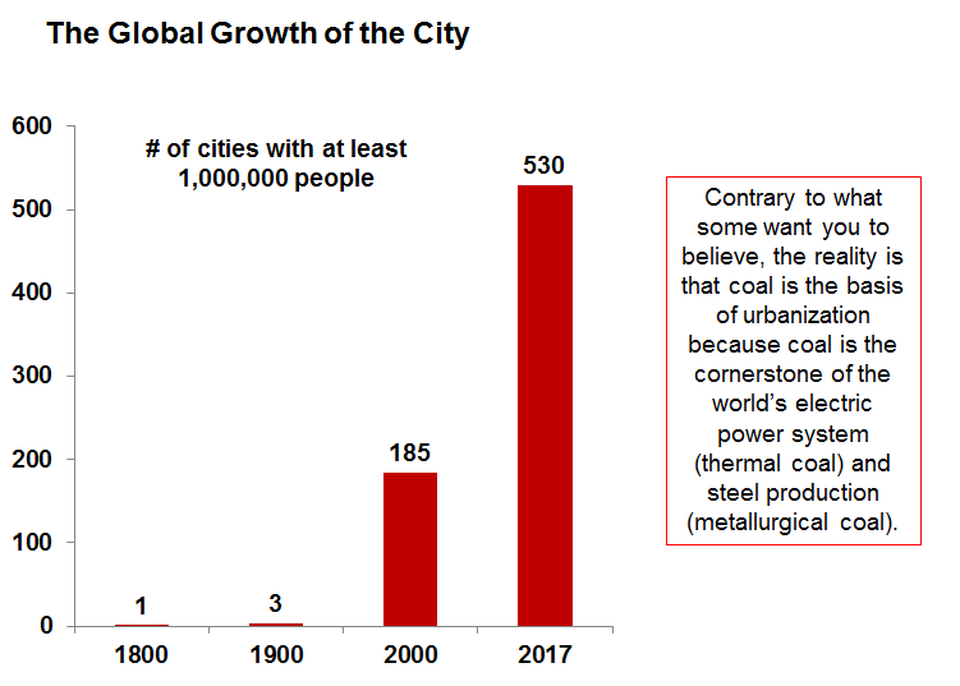The One Market That's Sure to Help Coal

By Jude Clemente
August 13, 2018 - As still the world's leading source of electricity (most critically, overwhelmingly so in all-important China and India) at 37-40% of all supply, and still generating 30% of U.S. power, coal is obviously not dead. But beyond electricity, coal is much more essential to another market than the anti-coal business may realize: the very steel that builds our cities. Apparently, unbeknownst to many, the fact that 70-80 million people move to the world's cities each year means that coal's fundamental role in the energy demand system is quite secure. It's no wonder then that global steel demand continues to surge to record highs and expected to increase 20% by 2030. Steel is an indispensable material for modern life. It is utilized in literally every important industry.
Metallurgical coal (also called coking coal) is a higher quality coal than the thermal coal (also called steam coal) that is utilized to generate electricity. It is used primarily in steel making and accounts for 10-15% of global coal usage. About 75% of the world’s steel production uses met coal as a critical ingredient. Here in the U.S., met coal is mostly produced in Appalachia, namely West Virginia.

The number of large cities continues to explode.
Data Source: UN; JTC
The ultimate irony? "There's about 150 tonnes of metallurgical coal via steel in an onshore windmill - and 250 tonnes of coal in an offshore one."
Met pricing is usually tied to global economic growth because an expanding economy means more construction which means more steel which in turns means more met coal demand. This means that future economic growth essentially ensures the growth of met coal demand. In the U.S., the proposed $1.5 trillion infrastructure build-out, for instance, is seen as a major boost for met coal because it would increase our demand for steel. Graded a poor D+ by the American Society of Civil Engineers, rebuilding our infrastructure has bipartisan support, yet nobody is talking about how much energy - from all sources - this is going to require.
In response to the Trump administration’s tariffs, retaliatory tariffs are now being considered really around the world, most importantly in China and Europe. These put downward pressure on coal pricing because tariffs work against global economic growth and thereby lower coal demand. Most of the coal that the U.S. exports, for instance, is met coal, with nearly 60 million tons shipped out last year. The touted coal mines that have been opening in the U.S. are met coal.
Met coal suppliers are optimistic that tariffs will help our domestic steel industry.
Met coal prices have been rising in recent years as China has shut down smaller mines due to safety concerns, so it has increasingly had to turn to the global market for imports. Coking coal prices have increased to $180-$200 a tonne from $75~ in the last few years, so companies with met coal mines have been performing better than those without. Yet, the burgeoning U.S. versus China and Europe trade war, along with slowing demand in China and stronger supply in Australia, could pull back prices to $130-$150 a tonne by 2020. Met coal prices though are subject to spikes because of falling coal mining CAPEX globally.
For the U.S., the Indian market will remain vital. As India builds its cities, future steel demand is great: per capita, India uses just 20% of the steel that the U.S. uses. And in India, more than 85% of met coal demand is filled by imports. Second to Brazil, India took 15% of U.S. met coal exports in Q1 of this year and nearly three times more than China did.
The march to global urbanization is a noble one.
The "pull factors" to cities are very strong for obvious reasons. People in cities live longer and make more money. That's because they have access to better jobs, educational opportunities, and health care. This is why the developed world is 80% or more urbanized, compared to around 35% in still-developing countries such as India and Bangladesh. And environmental groups should know that cities are "greener" because they restrict humanity's physical impact on the environment.
As a result, movement into urban areas is occurring on an unprecedented scale. Today, the world has over 30 cities with over 10 million people, compared to 10 in 1990. By 2050, there could be 110 such such “megacities.” Urbanization around the world is a great poverty reduction program: "Rapid growth and urbanization have been central to China's poverty reduction in the past 25 years,” World Bank.
The world is now 55% urbanized, compared to 30% in 1950 and 40% in 1980. By 2050, almost 70% of the nearly 10 billion humans that will inhabit planet Earth will live in cities. The truth is that cities cannot be built without coal because they cannot be built without electricity, steel, cement, and associated materials - all markets where coal plays a fundamental role.

